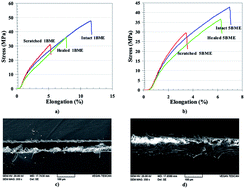Preparation of microcapsules containing multi-functional reactive isocyanate-terminated-polyurethane-prepolymer as healing agent, part II: corrosion performance and mechanical properties of a self healing coating
Abstract
The preparation of microcapsules made of a polyurethane (PU) shell, and multi-functional isophorone diisocyanate based polyurethane prepolymer core as healing agent (BIH) was reported in the first part of this work. The preparation of epoxy coatings loaded with PU-based microcapsules, the self-healing ability of these coatings, the resistance of self-healed coatings against corrosive media and the mechanical strength of these healed coatings are described in the present communication. For comparison, a similar coating system, loaded with microcapsules containing monomeric isophorone diisocyanate (IPDI) core as healing agent, was also prepared and subjected to the same evaluations. For reliable comparison of these two coating systems and to show that the nature of the healing agent was the sole determining factor on the recorded results, the same reactive core fraction, solvent content, shell material and shell wall thickness were considered for the prepared microcapsules. In addition, an equal weight percent of the added microcapsules was used for both systems. The salt spray test and electrochemical impedance spectroscopy (EIS) techniques were utilized to show the ability of these two systems to heal a cracked area artificially created in the coatings. The recorded results confirmed the superior ability of multi-functional high molecular weight isophorone diisocyanate based healing agents for the protection of damaged areas of coating against corrosive media. The ability of a healing agent to repair the coating material was also verified by comparing the tensile strength of the coatings before and after crack formation and the healing of the cracked area, respectively. The epoxy coating could regain up to 95% of its original tensile strength, when loaded with 10 wt% of microcapsules containing multi-functional isophorone diisocyanate based polyurethane prepolymer as healing agent.


 Please wait while we load your content...
Please wait while we load your content...